- Joined
- Sep 5, 2013
- Messages
- 3,207
I decided I needed to cut some gears, it seems to be a popular thing these days. The key word here is "decided", not "discovered", making this purely an adventure of desire rather than actual necessity. But it's a hobby, right? It's supposed to be fun.
Anyway, to cut said gears I would need gear cutters of which I had none. And the gear cutters I could find for the pitch I wanted (24 DP) all came with a 1" arbor hole. I have two arbors, both 7/8" diameter, of course. Hmmm....
I started with a piece of 1-1/4" 1018. I would have preferred 12L14 but my regular source is no longer stocking a lot of it anymore so 1018 was pretty much my only local option.
The spindle this has to fit has a #2 Morse taper and 3/8"-16 drawbar threads, so I needed to get those into the end of my 11" long bar somehow and without a steady rest. I opted to just mark out for centres by hand and then drill them using the drill press. In the same setup, I drilled and tapped the one end for the threads. Then I put a short hex bolt into the lathe collet, drilled a centre in the head, and then threaded that into the newly threaded drawbar end to reclaim the centre for turning the shaft.
And after all that talking, here it is on the lathe. I wasn't sure if I would get movement in the bar going from 1-1/4" down to 1", so I roughed all the dimensions first to about 50-thousandths oversize. It's been a while since I've turned between centres but I find I quite like it. At first I was getting quite a lot of chatter, so I changed from my ball bearing centre to a solid one and it quickly disappeared.
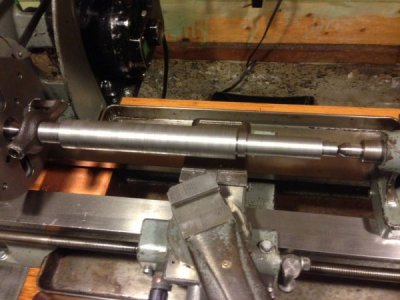
This was my first time cutting a Morse taper, and also the first time using the offset tailstock method. It works great! I would have liked just a hair better fit though, but I ran out of diameter before I could make that happen. It locks in ok and I think it will work, just didn't get quite as nice a bluing as I was hoping for. Next time.
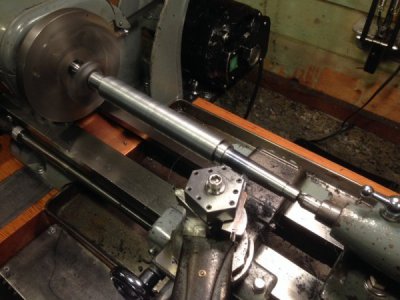
I did get the main 1" diameter on the money though, as well as the threads for the arbor nut. Did I mention this is for a horizontal machine? Well it is.
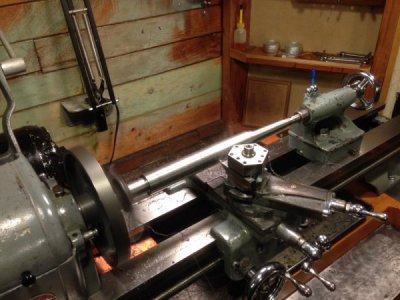
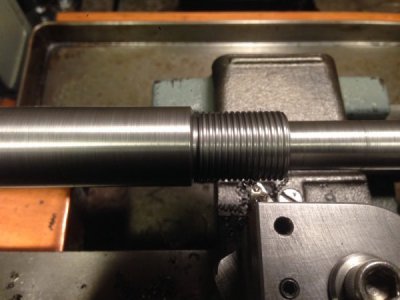
There also needs to be a collar just ahead of the Morse taper that can engage the drive dogs. Rather than having to use a bigger, bigger bar and turn the collar integral to the arbor, I decided to thread one on separately. And in order for that not to undo itself under load, it would have to be left hand threads. First time for those too.
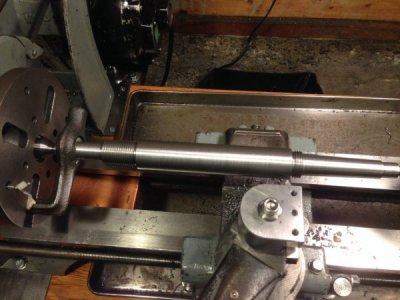
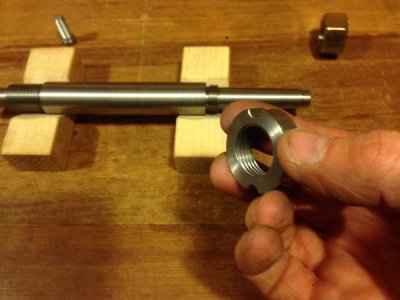
Cutting the keyseat for the full length of the shaft was less than elegant but it got done, and when the dust had settled all the pieces fit together. I still need a few more gear cutters to make up a set, but I've got two or three to play around with in the interim.
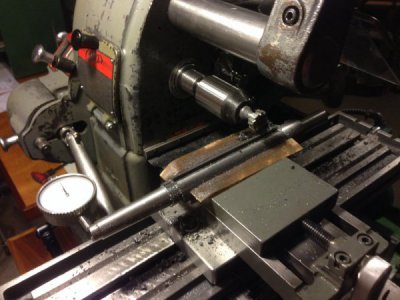
Thanks for looking!
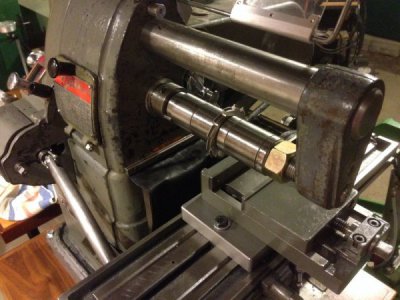
-frank
Anyway, to cut said gears I would need gear cutters of which I had none. And the gear cutters I could find for the pitch I wanted (24 DP) all came with a 1" arbor hole. I have two arbors, both 7/8" diameter, of course. Hmmm....
I started with a piece of 1-1/4" 1018. I would have preferred 12L14 but my regular source is no longer stocking a lot of it anymore so 1018 was pretty much my only local option.
The spindle this has to fit has a #2 Morse taper and 3/8"-16 drawbar threads, so I needed to get those into the end of my 11" long bar somehow and without a steady rest. I opted to just mark out for centres by hand and then drill them using the drill press. In the same setup, I drilled and tapped the one end for the threads. Then I put a short hex bolt into the lathe collet, drilled a centre in the head, and then threaded that into the newly threaded drawbar end to reclaim the centre for turning the shaft.
And after all that talking, here it is on the lathe. I wasn't sure if I would get movement in the bar going from 1-1/4" down to 1", so I roughed all the dimensions first to about 50-thousandths oversize. It's been a while since I've turned between centres but I find I quite like it. At first I was getting quite a lot of chatter, so I changed from my ball bearing centre to a solid one and it quickly disappeared.

This was my first time cutting a Morse taper, and also the first time using the offset tailstock method. It works great! I would have liked just a hair better fit though, but I ran out of diameter before I could make that happen. It locks in ok and I think it will work, just didn't get quite as nice a bluing as I was hoping for. Next time.

I did get the main 1" diameter on the money though, as well as the threads for the arbor nut. Did I mention this is for a horizontal machine? Well it is.


There also needs to be a collar just ahead of the Morse taper that can engage the drive dogs. Rather than having to use a bigger, bigger bar and turn the collar integral to the arbor, I decided to thread one on separately. And in order for that not to undo itself under load, it would have to be left hand threads. First time for those too.


Cutting the keyseat for the full length of the shaft was less than elegant but it got done, and when the dust had settled all the pieces fit together. I still need a few more gear cutters to make up a set, but I've got two or three to play around with in the interim.

Thanks for looking!

-frank

